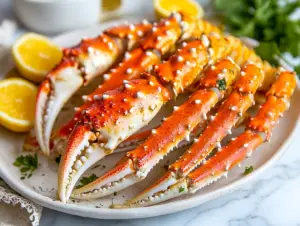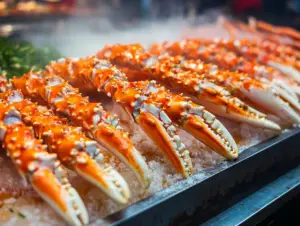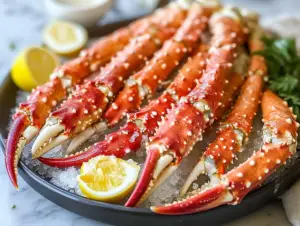Crab legs are a favorite delicacy among seafood lovers, but many argue that king crab legs are truly the best. From their colossal size to their sweet and rich flavor, crab legs have a reputation that sets them apart from other types of crabs. This article will dive deep into why crab legs are so popular, comparing them to other varieties, exploring their nutritional benefits, and detailing the best cooking methods to help you decide whether they’re worth the hype.
What Are Crab Legs?
King crab legs come from the crab, one of the largest crab species found in the cold waters of the North Pacific, particularly around Alaska and Russia. Known for their enormous size and tender, flavorful meat, these crabs are highly prized for fine dining and special occasions. Unlike smaller crab species, crabs are harvested for their meaty legs, which contain large portions of firm, sweet meat.Why Are King Crab Legs So Popular?
Several factors contribute to the popularity of king crab legs. Their large size provides more meat than other crabs, making them ideal for gatherings and celebrations. The sweetness and firmness of the meat also make them a favorite among seafood enthusiasts. These traits, combined with their versatility in the kitchen, ensure that king crab legs are often considered a premium option in seafood.
For anyone interested in the nuances between different crab types, this ultimate guide to buying king crab legs offers deeper insight into how crab legs compare to other species like snow crab and Dungeness crab.
King Crab vs. Other Crab Varieties
While king crab legs often top the charts, it’s essential to know how they compare to other types of crabs:
- King Crab vs. Snow Crab: Though snow crabs are more affordable, king crab legs deliver more meat and a richer taste. Snow crab has a thinner shell, which makes it easier to crack, but many people prefer the flavor and texture of king crab.
- King Crab vs. Dungeness Crab: Dungeness crabs are smaller, and while they are beloved for their sweet, delicate flavor, their meat yield pales in comparison to the hefty portions found in king crab legs. Seafood lovers often favor king crab for its firm texture and abundance of meat.
For more details on the differences between these crabs, this step-by-step guide to cooking king crab legs breaks it down further.
Nutritional Value of Crab Legs

In addition to their exquisite flavor, king crab legs offer impressive nutritional benefits:
- High in Protein: A 100-gram serving of king crab provides around 16-19 grams of high-quality protein, making it a great choice for muscle maintenance and repair.
- Low in Fat: Despite its rich taste, king crab is low in fat, containing only about 2-3 grams of fat per 100 grams of meat. This makes it a heart-healthy option for seafood lovers.
- Rich in Omega-3 Fatty Acids: These essential fats are known for promoting heart health, reducing inflammation, and supporting brain function.
- Packed with Essential Vitamins and Minerals: King crab legs are rich in vitamins like Vitamin B12, essential for nerve health, and minerals such as zinc and copper, which support the immune system and bone health. The selenium content in king crab also acts as a potent antioxidant, aiding thyroid function and protecting the body from oxidative stress.
Incorporating king crab into your diet offers a flavorful way to boost your intake of these essential nutrients.
How to Cook King Crab Legs
Versatility in cooking is one of the reasons king crab legs are so popular. Whether you’re a fan of grilling, boiling, steaming, or baking, there’s a method that will highlight the sweet, rich flavor of these crabs.
Boiling King Crab Legs
Boiling is a straightforward method that keeps the crab’s natural flavor intact.
- Fill a large pot with salted water and bring it to a boil.
- Add the king crab legs and cook for 4-5 minutes.
- Once heated, serve immediately with melted butter.
Steaming King Crab Legs
Steaming allows the crab legs to remain tender and juicy.
- Place a steaming rack in a large pot with a few inches of water at the bottom.
- Bring the water to a boil, then place the crab legs on the rack.
- Cover the pot and steam for 5-7 minutes.
Grilling King Crab Legs
For those who enjoy smoky, charred flavors, grilling king crab legs is a great choice.
- Preheat your grill to medium-high heat.
- Lightly coat the crab legs with olive oil or melted butter.
- Grill the legs for 4-5 minutes per side until they are heated through and slightly charred.
Baking King Crab Legs
Baking king crab legs allows you to infuse them with additional flavors. Garlic butter or herbs work well with this method.
- Preheat the oven to 350°F (175°C).
- Place the crab legs on a baking sheet and brush them with melted butter and seasonings.
- Bake for 15-20 minutes.
Each of these methods offers a different flavor profile and cooking experience, so experiment to find your favorite way to prepare king crab legs.
Where to Buy the Best King Crab Legs

Finding high-quality king crab legs can make all the difference in your dining experience. Here are some things to keep in mind when shopping for them:
- Fresh vs. Frozen: Fresh king crab offers the best taste, but it can be difficult to find unless you live near the coast. Flash-frozen king crab legs, which are frozen right after being caught, are widely available and can taste just as good when prepared correctly.
- Wild-Caught vs. Farmed: The best king crab comes from wild-caught fisheries, particularly from Alaska. Wild-caught crabs not only taste better but are also harvested in a more sustainable manner.
If you’re looking for a trusted source to buy king crab legs, Alaska King Crab Online is one of the top providers. For alternative options, Global Seafood also offers high-quality seafood delivered straight to your home.
Why Are King Crab Legs So Expensive?
The high price of king crab legs is due to several factors:
- Seasonal Harvesting: King crabs are typically harvested during a short window in the winter, making them more scarce.
- Labor-Intensive Fishing: Harvesting king crabs is dangerous and requires expert fishermen. The risk and effort involved in catching them add to their high cost.
- Size and Meat Yield: The massive size of king crabs means that fewer crabs are needed to satisfy a meal, but it also means fewer crabs are caught during each fishing season.
Though pricey, many people believe that king crab legs are worth every penny for their quality, flavor, and nutritional value.
Pros and Cons of Crab Legs
Like any premium food, king crab legs come with their pros and cons:
Pros:
- Rich, Sweet Flavor: The taste of king crab legs is unparalleled in the seafood world.
- Nutritional Powerhouse: Packed with protein, omega-3s, and essential vitamins and minerals, king crab legs are a healthy choice.
- Impressive Meat Yield: King crab legs offer larger portions of meat compared to other types of crab, making them ideal for hearty meals.
Cons:
- High Cost: King crab legs are expensive, often putting them out of reach for budget-conscious consumers.
- Limited Availability: Due to their seasonal harvest and specific geographic origins, finding fresh king crab can be a challenge.
- Difficult to Handle: Their large size and tough shell can make them harder to cook and eat, particularly for those unfamiliar with them.
Final Verdict: Are Crab Legs the Best?
After weighing all the factors—flavor, texture, nutritional benefits, cooking versatility, and price—it’s easy to see why so many people consider king crab legs the best in the seafood world. They may be more expensive and harder to find, but the rich, satisfying taste of their sweet, firm meat makes them a must-try for any seafood lover. If you’re seeking a premium seafood experience, you won’t be disappointed with crab legs.
FAQs About Crab Legs
1. Is King Crab Better than Snow Crab?
In most cases, yes. King crab offers more meat and a richer flavor, though snow crab is more affordable and easier to crack.
2. Why Are King Crab Legs So Expensive?
Their price reflects the difficulty of harvesting king crabs and their limited availability during the year.
3. How Should I Store Crab Legs?
If fresh, consume within 2-3 days. Frozen crab legs can be stored in the freezer for up to six months.
4. What’s the Best Way to Cook King Legs?
Steaming and grilling are popular methods, but boiling and baking work well too, depending on your preferences.
5. How Do You Defrost Frozen Crab Legs?
The best way is to defrost them overnight in the refrigerator. For a quicker method, run them under cold water.

Conclusion
In the world of seafood, crab legs hold a prestigious position for good reason. Their exceptional size, sweet and firm meat, and rich nutritional profile make them a luxurious and satisfying choice for any seafood lover. While their price and availability may be limiting factors, the unparalleled flavor and versatility in cooking more than justify the investment for those seeking a premium dining experience.
Whether you enjoy them steamed, grilled, or baked, crab legs offer a truly indulgent taste of the ocean. For special occasions or a decadent meal, they are often considered the best option, standing out among other crab varieties for their superior flavor and texture. Ultimately, if you’re looking to treat yourself to the finest seafood, crab legs are undoubtedly a choice you won’t regret.

